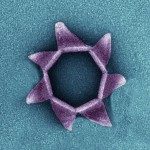Link to Pubmed [PMID] – 22440622
Curr Opin Virol 2011 Aug;1(2):118-24
The number of viral particles in the biosphere is enormous. Virus classification helps to comprehend the virosphere and to understand the relationship between different virus groups. However, the evolutionary reach of the currently employed sequence-based approaches in virus taxonomy is rather limited, producing a fragmented view of the virosphere. As a result, viruses are currently classified into 87 different families. However, studies on virion architectures have unexpectedly revealed that their structural diversity is far more limited. Here we describe structures of the major capsid proteins of double-stranded DNA viruses infecting hosts residing in different domains of life. We note that viruses belonging to 20 different families fall into only five distinct structural groups, suggesting that optimal virus classification approach should equally rely on both sequence and structural information.

